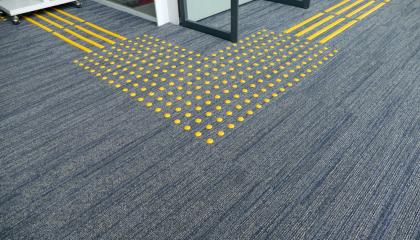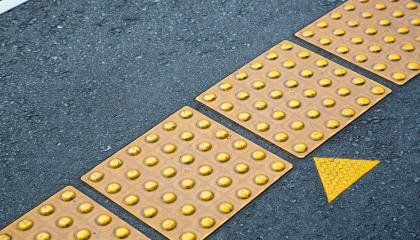While walking on the sidewalks, you may have noticed small, colorful bumps where the sidewalk meets the road. What are these bumps? Why are they placed so strategically at the edge of the sidewalk, at crosswalks, and near public transportation? What purpose do they serve? Are they there to increase the grip on the road? Or, do they serve some other purpose? Let’s find out!
While the quality and durability of the detectable warning dome tiles are absolutely vital, they are only as good as their installation process. Let’s talk about installation processes.
Installation is when two or more materials are adhered together to form a strong bond. In this case, we have the detectable warning dome tiles that will be bonded to the substrate, the underlying substance or layer, with an adhesive. All the materials might be of the highest quality, but if the installation process is poor, then the integrity of the other materials will be compromised.
Truncated domes or detectable warning tiles are designed to withstand sustained pedestrian traffic, and in order for them to remain reliable over the span of many years, a minimum compression strength of 12K psi is recommended. From severe weather conditions to heavy commuter traffic, detectable warning dome tiles must be ready to withstand the ambient conditions that will consistently test the integrity of the structure.
How detectable warning tiles are installed is crucial to the longevity of the project. There are two types of installations that you need to know about: wet-set and thin-set. Both the wet-set and thin-set installation methods can be used on new construction as well as upgrading pre-existing ramps. Each type of installation can provide longevity and durability when installed correctly.
On Monday, March 18th, Google Doodle featured the Japanese inventor of detectable dome tiles, Seiichi Miyake. His invention changed the world by empowering and protecting individuals with visual impairments to cross streets with greater ease. Fifty-two years have passed since the first dome tiles were installed, and these detectable warning tiles are now part of many cities throughout the world.
Cities and businesses are scrutinizing pedestrian walkways to determine how to best increase the ADA compliance of public spaces. ADA compliant sidewalks make businesses and public areas more accessible to individuals with disabilities. A key component of an ADA compliant sidewalk is the truncated dome tiles that warn pedestrians of a change in the sidewalk, whether an intersection or a ramp.
These truncated dome tiles have two common ways of being installed: cast-in-place or surface-applied.
Connect with us
We pride ourselves on our customer service, and we'd love to hear from you! Sign up for our newsletter to keep up with industry updates and trends, as well as any new product releases.









